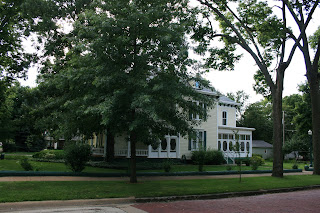

In July my wife, Mitzi and I took a road trip to the 100th annual meeting of Northern Nut Growers at Purdue University. Along the way, we decided to stop at some mature urban plantings to see how seedlings perform long term in the urban environment. We were looking for evidence of trees planted in treeshelters that should be long gone. I was worried I would not be able to find the trees and how would I tell the tree tubed from an ordinary tree. It was easier than I ever imagined. When I saw this tree and I knew it was too small, but it had an early 1990s Tubex Brand Treeshelter. The treeshelter was obviously reused on a new tree. This confirmed the success of the project in the eyes of the residents. I knew then we were on the right street.

Pekin had lost a large number of trees and decided to reforest the city with a lower cost technology that allowed some native trees if the owner wanted them. Small young ornament plants were offered too. These were the small samplings normally grown to large size in a nursery before extraction and planting in the landscape. In Pekin the landscape trees were grown in the landscape and never disturbed by a tree spade.

I was so excited to see the trees. The trees look great. There are no signs of girdling roots - so common when transplanting large 
This owner on the left is also doing his tree a great favor by protecting the base from mower damage. 
The number of gorgeous homes and well cared for trees amazed me. These trees are healthy and add thousands of dollars in value to the homes they serve. Below are some more examples of beautiful homes and gorgeous trees.








No comments:
Post a Comment